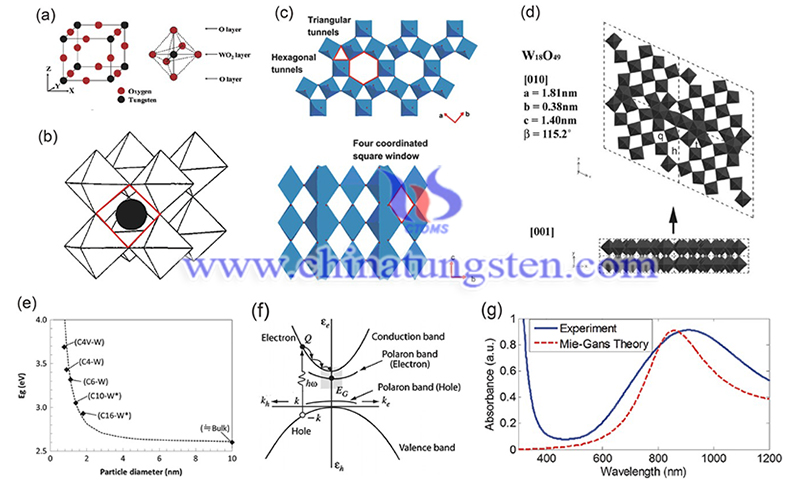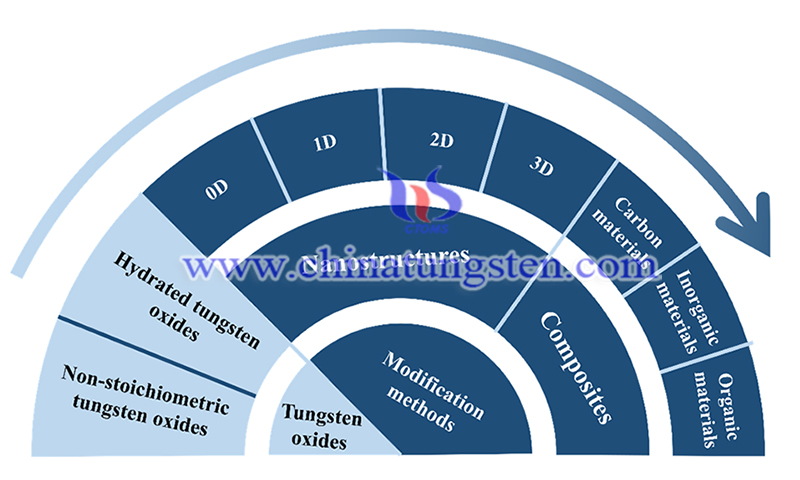Tungsten Oxide Polymorphs and Applications
- Details
- Category: Tungsten Information
- Published on Tuesday, 12 April 2022 11:40
Considerable interest in tungsten oxide polymorphs (WO3-x) nanomaterials has been generated due to their abundance in nature, easy availability, high stability, non-recombination, and chemical diversity, and many advances have been made from traditional catalysts and electronics to emerging artificial intelligence. A recent study from Qingdao University presents the latest progress of WO3-x polycrystals and their multifunctional applications.
The study titled “Tungsten oxide polymorphs and their multifunctional applications” has been published in the Advances in Colloid and Interface Science (2022, 300). The study was carried out by Mingxin Zhang et al.
As a universal semiconductor widely present in nature, tungsten oxide (WO3-x, x ≥ 0) and its derivatives have been intensively used in smart windows, display devices, gas sensors, photocatalytic systems, photoelectric switches, information memories, etc. WO3-x is a typical ReO3-type perovskite structure with non-recombination, acid resistance, thermal stability, and chemical diversity. Compared with their conventional counterparts, this type of semiconductor nanostructure presents better performance and, therefore, its utilization is increasing.

Since tungsten oxide polymorphs hold a narrow bandgap of about 2.5-2.8 eV, it has good photosensitivity and electron transport properties. Therefore, it has attracted a lot of attention in photo(electro)catalysts, photochromic agents, phototherapy, and optoelectronics. The presence of non-recombination, i.e., different oxidation states, has led to an intensive study of oxygen-deficient WO3-x (e.g., W18O49, WO2.83, and WO2.9) in the fields of electrochromism, electrochromic, catalysis, and gas sensing.
The realignment of atoms in the lattice significantly affects the Fermi-level positions, bandgap, and carrier density, which brings additional physicochemical advantages to WO3-x materials. In addition to the desired stability and non-recombination, the structural diversity of WO3-x and its crystalline phase transition facilitate the transport of small ions and charges, which has promising applications in ionic and ion electronics, such as memories, electrolyte-gated transistors, and supercapacitors. In addition, WO3-x has emerged as one of the most promising candidates for novel antibiotics, solar cells, and artificial intelligence.
Information processing in the human brain is efficient and complex. When a large number of electrical signals reach presynaptic neurons, enough neurotransmitters are released to receptors due to stimulation by Ca2+ production in voltage-gated calcium channels. Although intelligent computers are excellent at processing information and performing numerical calculations, they often require complex algorithms and consume enough power to perform these intelligent tasks.
Therefore, it is necessary to construct simulated synapses for efficient artificial neural computation. WO3 is a pseudo-perovskite without A-site cations, which provides sufficient gap space for ion insertion and extraction due to the absence of site-specific cations, making it an excellent model material for artificial synaptic devices. Some researchers have designed an electrolytic gated transistor structure by pulsed laser deposition method using WO3 epitaxial film to simulate the function of biological synapses.

By scanning the gate voltage (VG) from 0 to 1.0 V, 1.0 to 1.0 V, and back to 0 V, the channel conductance opens at positive gate bias and closes at negative gate bias, indicating that the electrolyte-gated WO3 structure is highly supervised. The researchers suggest that the changes in valence and conductivity of the WO3 film are related to the insertion of water-contaminated protons in the ionic liquid, as the gate current (IG) curve shows a small peak near 1.6 V.
In addition, researchers have reported a promising approach to combining tantalum-doped tungsten oxide (Ta-WOx) and polythiophene-derived poly (PDCBT) for perovskite solar cells, which increases the maximum power efficiency without compromising solar cell stability.
With the advancement of science and medicine, tungsten oxide with good antimicrobial activity and biocompatibility is considered as a potential candidate to replace overused conventional antibiotics. Although photodynamic therapy (PDT) and photothermal therapy (PTT) have been widely used, malignant tumors cannot be completely eradicated by these two therapies. Therefore, combining PDT and PTT to improve antitumor efficacy is a novel attempt. Some researchers have synthesized a novel dopamine-coated tungsten oxide nanodots (WO3-x/Dpa-Mel NPs) by solvothermal method using dopamine as a reducing agent.
The researchers also prepared undoped and nickel-doped WO3 nanosheets using a chemical co-precipitation method and investigated the effect of nickel doping on the anti-cancer activity of WO3. With the doping of nickel ions, the particles maintained the plate-like morphology. However, the thickness of the nanoplates decreased slightly with the doping of nickel ions, and 5% nickel-doped WO3 showed excellent performance in reducing the percentage of cell viability of MCF-7 and Hep-2 cancer cells.
Due to its unique physical and chemical properties, tungsten oxide polycrystals have become one of the most widely studied functional metal oxides.
In the field of photocatalytic applications, tungsten oxide polymorphs with low excitation energy and high chemical stability are expected to be comparable to conventional TiO2. In the near future, it will be necessary to remove the single performance limitation. Resistive WO3-based gas sensors that need to operate at high temperatures not only consume high power but also have short lifetimes. Replacing high temperatures with other energy to control charge transfer and carrier concentration will enable gas sensors to operate at room temperature.
The excellent properties of WO3 also offer unlimited possibilities for the medical treatment of diseases and the elimination of cancer. Therefore, more research is needed on the technological development and performance improvement of tungsten oxide polymorphs materials.
- Tungsten Manufacturer & Supplier, Chinatungsten Online: www.chinatungsten.com
- Tungsten News & Prices of China Tungsten Industry Association: www.ctia.com.cn
- Molybdenum News & Price: news.molybdenum.com.cn
- Tel.: 86 592 5129696; Fax: 86 592 5129797; Email: sales@chinatungsten.com



 sales@chinatungsten.com
sales@chinatungsten.com